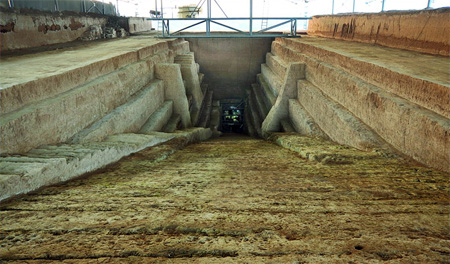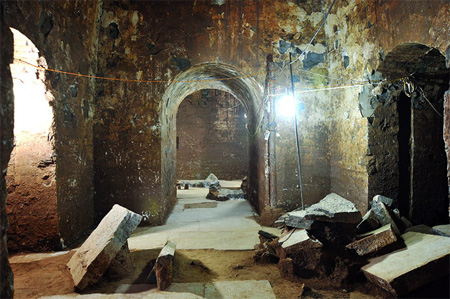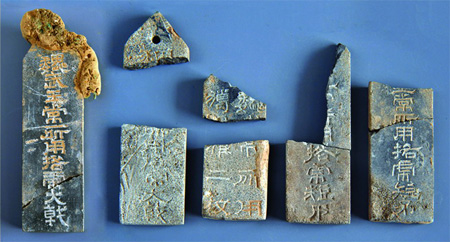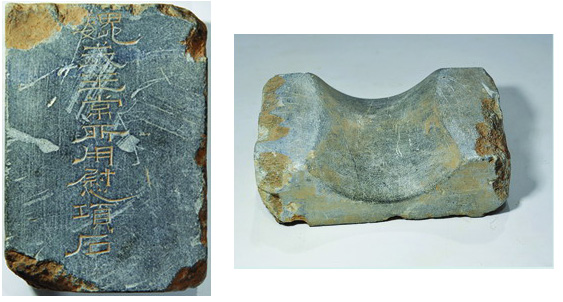The Gao Mausoleum of Cao Cao in Anyang County, Henan Province
From December of 2008 to December of 2009, the Henan Provincial Institute of Cultural Heritage and Archaeology opened two tombs, labeled No.1 and No.2, at Xigaoxue Village in Anyang County, 15km from Anyang City.

Tomb No.2 is oriented eastward at an angle of 110oC. It is equipped with a long ramp and a trapezoidal chamber of 18m×(19.5-22)m or 740m2 in dimension. The arched brick doorway, 1.95m wide and 3.02m high, is sealed with stone door fans and three layers of brick walls. The chamber, also built of bricks, consists of two rooms, each of which has two side rooms. The two main rooms are nearly square and each crowned with quadruple cones. The side rooms are arched instead. The floors of these rooms are paved with stone bricks. From remaining fragments, the door fans originally bear carvings of motifs such as “sacred animals,” “seven daughters retaliate,” “chariot of king of the Song State,” “ten sons of King Wen,” etc. The tomb contains altogether skulls of three individuals. Two skulls, found in the rear room, are of females, whereas the other, found at the doorway of the ante-room, is of a male. It is estimated that the male is around 60 in age whereas the two females are around 50 and 20.


Tomb No.2 has been plundered multiple times, yet it produces a number of artifacts. Among them no less than 250 items are restorable. They include ritual artifacts (stone gui-tablets, bi-discs), weapons (iron armors, swords, arrowheads, arrow chargers), chariot fittings (bronze bow-end caps, bronze canopy caps, bronze bells, jet stone tiger figurines), utensils (pottery inkstones, stone pillows, bronze hooks, mirrors, knives, etc.), ornaments (jade beads, crystal beads, agate beads), pottery wares (stoves, ear-cups, plates, pots, jars), and 59 inscribed tablets. Some tablets are rendered in the shape of gui (ritual object, rectangular body with a triangular tip), and inscribed with “Wei Wuwang chang suoyong gehu daji (tiger-hunting ji-spear used by King Wu of Wei),” “Weiwuwang chang suoyong gehu duanmao (tiger-hunting short spears used by King Wu of Wei), etc. The other are rendered in the shape of hexagon, and inscribed with types and quantities of objects, such as “huanglingpao jinglingxiu yi (one item of yellow silk gown and satin collar),” “jingtai yi (one item of mirror stand),” “shu’an yi (one item of writing desk),” and “quzhen yi (one item of pillow).” These inscriptions are written in the Han-clerical style. The size and structure of the tomb, in combination with objects, tablet inscriptions, and human bones indicate that this tomb is the Gao Mausoleum of Cao Cao, a prominent politician who unified northern China after the collapse of the Eastern Han

The dates of the death and interment of Cao Cao are well recorded and this tomb provides a yardstick for dating other tombs. The tomb structure and artifactual assemblage indicate that the interment of Cao Cao strictly complies with his own wish, which demands “no building of mound, no erecting of stele,” and “wrapping of daily garments without any deposit of gold and jade treasures.” This tomb thus testifies to the policy of thrifty interment implemented during the Wei and Jin Periods. (Translated by Zhang Liangren)

